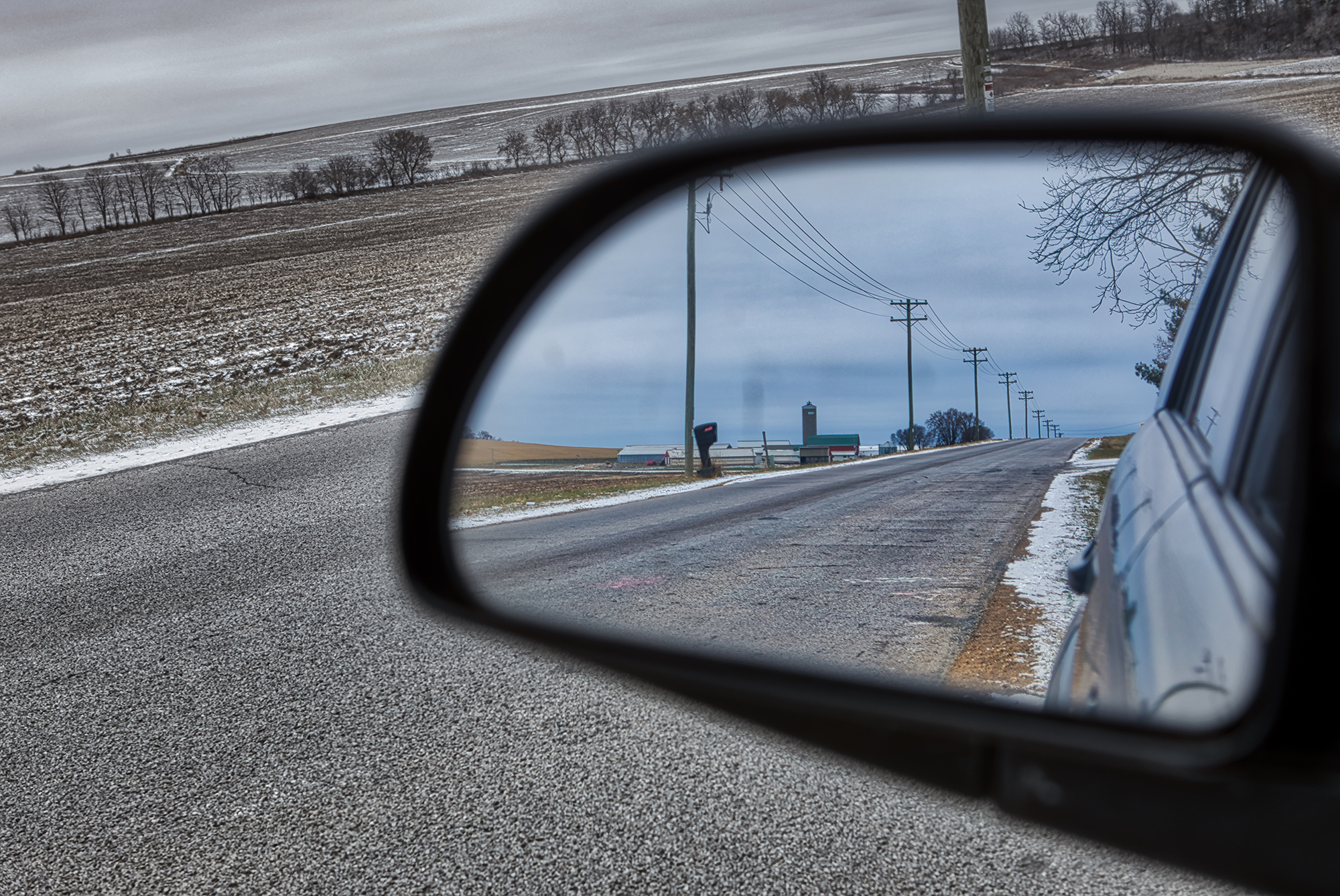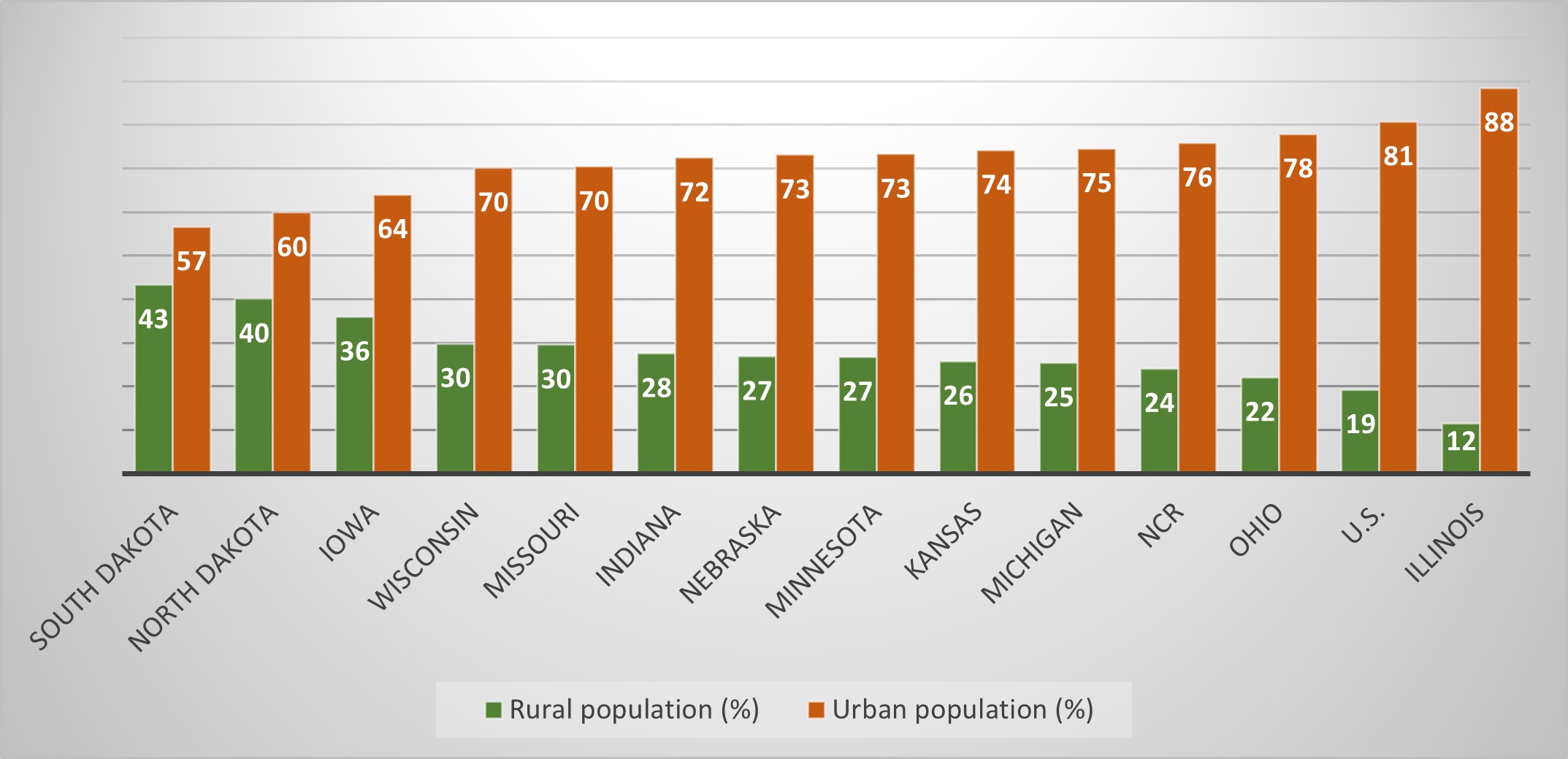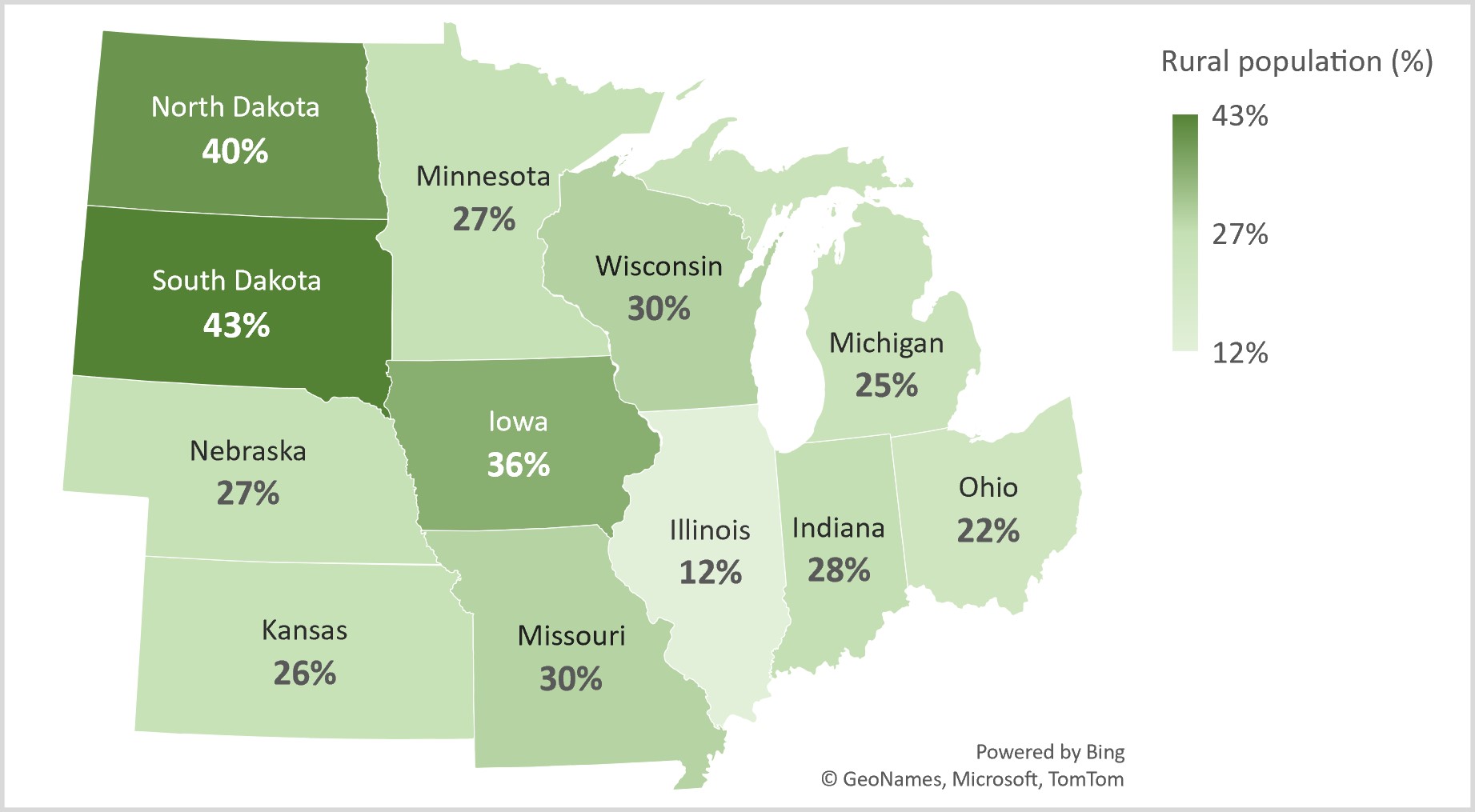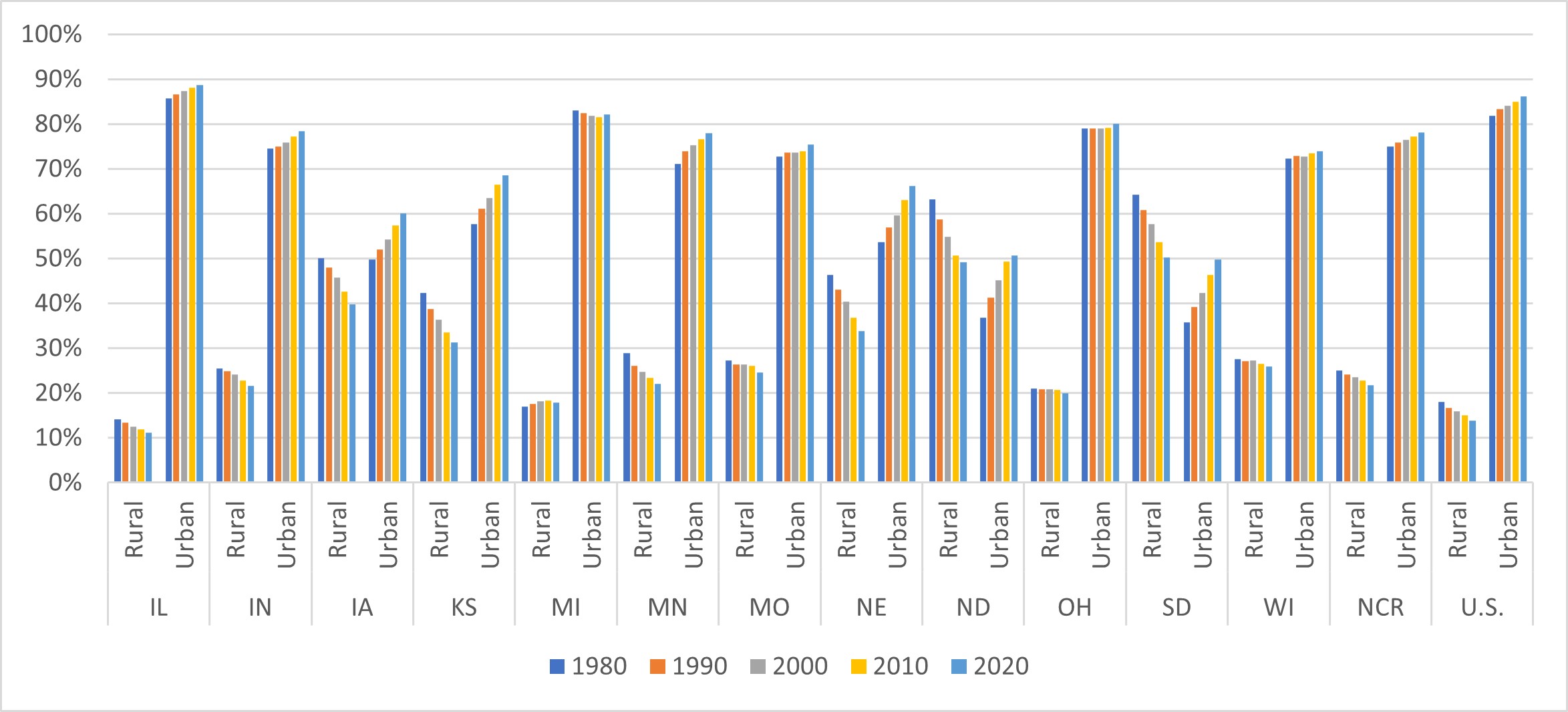
Rural communities in the North Central Region (NCR) are facing many of the same trends observed in rural communities across the nation: slow population growth, aging population, shrinking household size, diminishing median household income, and relatively small percentages of residents with post-secondary education.[1] These aspects weaken community prosperity and contribute to population changes in rural communities.
Population change consists of natural change (births minus deaths) and net migration (immigrants minus outmigrants). Several factors contributed to the natural decrease of the rural population. The continuous outmigration of rural young adults has led to an aging rural population, resulting in fewer births and more deaths. Moreover, rural women, in line with national trends, are having fewer children. The higher death rate among working-age adults is a more recent and unexpected trend that also negatively impacts population growth.[2]
Negative net migration also causes rural population loss and has significantly decreased the number of inhabitants in some rural areas. For example, between 2000-2010, net outmigration led to a decline of 20-24-year-old young adults in nonmetropolitan counties by 28%, compared to an 8% drop in metropolitan counties.[3] Rural outmigration since 2006 has been a reaction to, in particular, rising unemployment and housing-market challenges. While natural changes have been progressively decreasing since the 1980s, migration rates fluctuate in response to economic conditions.[4] As a result, negative net migration rates were always offset by higher rates of natural increase in the past. However, since 2010, the natural increase in rural population has not compensated for negative net migration.[5]
Researchers, federal agencies, and policymakers employ different definitions for rural and urban areas. Still, all the definitions show a common feature for rural areas – persistent population loss in hundreds of small rural communities across the country.
U.S. Census Bureau’s definition of urban and rural areas
The U.S. Census Bureau defines rural and urban areas on the basis of population size and density. [6],[7] The delineation is at 2,500 people.
Metro (urban) areas are based on population density or the extent to which areas are built-up and densely settled. Urbanized areas contain 50,000 or more people, and urban clusters have at least 2,500 people but less than 50,000.
Nonmetro (rural) areas consist of (a) open countryside with population densities less than 500 people per square mile and (b) places with fewer than 2,500 people.
The Census Bureau defines urban areas after each decennial census. Based on this definition, in 2010, urban areas in NCR contained 75.9% of the region’s population. Nationally, 80.7% of the population was in urban areas. Most (83%) of the urban population in the NCR live in urbanized areas (compared to 88% nationally.), and 17% live in urban clusters (compared to 12% nationally.). Rural areas in the Midwest comprised 24.1% of the region’s population (compared to 19.3% nationally) (Figure 1).[8]
Figure 1. Share of rural-urban population in the U.S. and NCR based on the U.S. Census rural-urban definition, 2010
 Source: U.S. Census Bureau
Source: U.S. Census Bureau
Figure 2 shows the geographical distribution of the rural population in the NCR and significant disparities between the states in 2010. With 24% of the rural population, the NCR is a more rural region than other regions. The share of rural population in the Northeast is 16%, in the West 10%, and in the U.S. 16%. Only the South has a similar share of the rural population (23%). The NCR, especially South Dakota (43% of rural population) and North Dakota (40%) with large remote rural areas, represent significantly rural states. In contrast, Illinois, a highly urbanized state with the Chicago metropolitan area, is the only state in the NCR where the share of the rural population is under the national percentage (12%).
Figure 2. Share of the rural population in the NCR by state based on the U.S. Census rural-urban definition, 2010
 Source: U.S. Census Bureau
Source: U.S. Census Bureau
Economic Research Service’s definition of rural areas
The Economic Research Service (ERS) of the U.S. Department of Agriculture uses a modified definition of rural counties that include a combination of
- open countryside,
- rural towns (places with fewer than 2,500 people), and
- urban areas with populations ranging from 2,500 to 49,999 that are not part of larger labor market areas (metropolitan areas).[9]
Based on this definition, Figure 3 shows trends in rural and urban population change between 1980 and 2020 for the states within the NCR and nationally.
All the NCR states except Michigan follow the national trend in rural depopulation. Rural populations declined by 4.2% in the U.S. and 3.2% in the NCR over the last 40 years. However, several NCR states have experienced more significant rural population downturn – South Dakota by 14%, North Dakota by 13.9%, Nebraska by 12.5%, Kansas by 11%, and Iowa by 10.3%.
Figure 3. Share of rural-urban population in the NCR and the U.S. based on the ERS rural-urban definition, 1980 – 2020
 Source: ERS State Fact Sheets. https://www.ers.usda.gov/data-products/state-fact-sheets/
Source: ERS State Fact Sheets. https://www.ers.usda.gov/data-products/state-fact-sheets/
A review of population change illustrates different, often opposite, trends within a state. Some counties (primarily urban, suburban, or urban adjacent counties) gain population, while others lose (mainly remote rural counties). An increase in the rural population in Michigan may correspond with population growth concentrated in recreation areas with beautiful scenery and retirement destinations in Lake Michigan. Recreation, tourism, and retirement economies generate jobs in the construction and service sectors that attract new migrants.
The dominant flow of people in the Great Plains states, including Iowa, Kansas, Minnesota, Nebraska, North Dakota, and South Dakota, is from rural to urban. These states are characterized by vast expanses of sparsely populated areas. Manufacturing-dependent rural counties were heavily impacted by job losses in manufacturing caused mainly by the economic recession, increased global competition, and technological changes. Technological modernizations in agriculture dramatically reduced the need for labor in farm-dependent counties.[10]
The high outmigration that began in 2007 emphasizes the new challenging situation that many rural communities face. The grouping of counties with persistent population loss in regions such as the Great Plains illustrates that population decline is associated with low population density, low urban accessibility, and long very cold winters in the Upper Midwest. Currently, rural outmigration is too high to be compensated by the rural natural growth, which can lead to an alarming depopulation of rural and remote rural areas. Thus, rural communities will need policies that help them adjust to aging populations, fewer workers, and declining incomes.[11],[12]
[1] USDA: Rural America at a Glance. 2018 Edition. United States Department of Agriculture.
https://www.ers.usda.gov/webdocs/publications/90556/eib-200.pdf?v=8480.6
[2] USDA: Rural America at a Glance. 2017 Edition. United States Department of Agriculture.
https://www.ers.usda.gov/webdocs/publications/85740/eib-182.pdf?v=2660.8
[3] Cromartie, J., von Reichert, Ch., and Arthun, R. 2015. Why Some Return Home to Rural America and Why It Matters. Economic Research Service. United States Department of Agriculture.
[4] Economic Research Service. Population and Migration. United States Department of Agriculture.
https://www.ers.usda.gov/topics/rural-economy-population/population-migration/
[5] Economic Research Service. Population and Migration. United States Department of Agriculture.
https://www.ers.usda.gov/topics/rural-economy-population/population-migration/components-of-population-change/
[6] U.S. Census Bureau: Understanding and Using American Community Survey Data – What Users of Data for Rural Areas Need to Know
[7] U.S. Census Bureau: Defining Rural at the U.S. Census Bureau. 2016. https://www.census.gov/content/dam/Census/library/publications/2016/acs/acsgeo-1.pdf
[8] U.S. Census Bureau: Defining Rural at the U.S. Census Bureau. 2016. https://www.census.gov/content/dam/Census/library/publications/2016/acs/acsgeo-1.pdf
[9] Economic Research Service, U.S. Department of Agriculture: https://www.ers.usda.gov/topics/rural-economy-population/rural-classifications
[10] Rathge, R.W. The changing Population Profile of the Great Plain.
https://www.ndsu.edu/fileadmin/csr/Archived_Research/Reports/ChangingPopulationPaper.pdf
[11] Cromartie, J., von Reichert, Ch., and Arthun, R. 2015. Why Some Return Home to Rural America and Why It Matters. Economic Research Service. United States Department of Agriculture.
https://www.ers.usda.gov/amber-waves/2015/july/why-some-return-home-to-rural-america-and-why-it-matters/
[12] Economic Research Service. Population and Migration. United States Department of Agriculture.
https://www.ers.usda.gov/topics/rural-economy-population/population-migration/components-of-population-change/
Author: Zuzana Bednarikova, zbednari@purdue.edu
Dr. Zuzana Bednarikova is a Research and Extension Specialist at NCRCRD.
